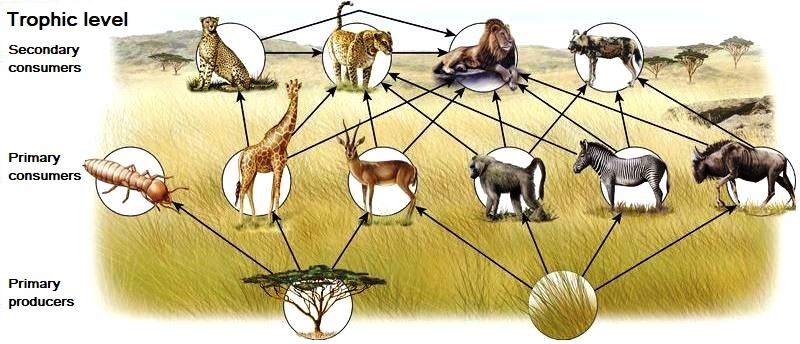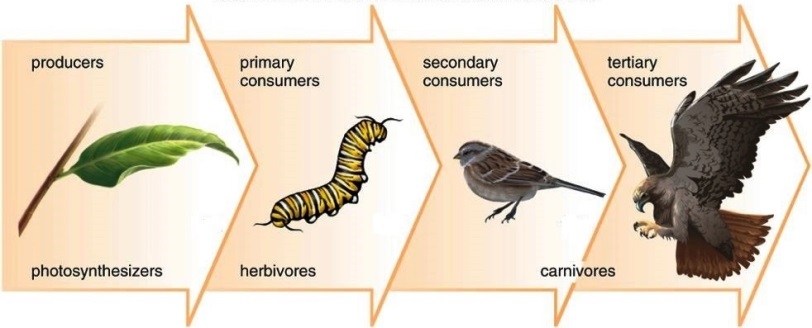Key Concepts
A diagram depicting those organisms that eat other organisms in the same ecosystem. A food web (Fig. 1) is a graphical model that illustrates feeding relationships at various, changing trophic levels. In some cases, the organisms that are consumed may already be dead. Overall, a food web is a network of energy flows in and out of the ecosystem of interest, and a food web helps depict how an ecosystem is structured and functions. The energy flows in a food web can be very large, and some ecosystems depend almost entirely on energy that is imported. A food chain is one particular route through a food web. In addition, most published food webs omit predation on minor species, the quantities of food consumed, the temporal variation of the energy flows, and many other details. See also: Ancient food web interactions; Ecological communities; Ecological energetics; Ecological modeling; Ecology; Ecosystem; Trophic ecology

Food chains
One way to describe and simplify various food chains is to count the most common number of levels from the top to the bottom of the web. Food chains are usually short, and the shortest food chains have two levels. Most food chains are three or four trophic levels long (if parasites are excluded), although there are longer ones.
Along a simple food chain, A eats B, B eats C, and so on. For example, the energy that plants capture from the sun during photosynthesis may end up in the tissues of a hawk. It gets there via a bird that the hawk has eaten, the insects that were eaten by the bird, and the plants on which the insects fed (Fig. 2). Each stage of the food chain is called a trophic level. More generally, the trophic levels are separated into producers, herbivores or primary consumers, carnivores or secondary consumers, and top carnivores or tertiary consumers.

Food chains may involve parasites as well as predators. For example, the lice feeding in the feathers of the aforementioned hawk are yet another trophic level. When decaying vegetation, dead animals, or both are the energy sources, the food chains are described as detrital. See also: Parasitology; Predator-prey interactions
Energetics
There are several possible explanations for why food chains are generally short. The first involves energy. In many ecosystems, there are more plants than insects, more insects than insectivorous birds, and more insectivorous birds than hawks. These ecological pyramids reflect an underlying energetic constraint. For example, when insects eat plants, they convert energy locked in plant tissues into insect tissue. Yet, they pay an energetic cost in doing so. Mammals and birds pay an even greater cost. Only about 1% of the energy of the food consumed goes to produce new tissues. The rest is lost as heat—both for warmth and as a by-product of the conversion process.
Thus, between each trophic level, much of the involved energy is lost as heat. As the energy passes up the food chain, there is less and less to go around. There may not be enough energy to support a viable population of a species at trophic level five or higher.
This energy-flow hypothesis is widely supported, but it is also criticized because it predicts that food chains should be shorter in energetically poor ecosystems, such as bleak tundra or extreme deserts. However, these systems often have food chains similar in length to energetically more productive systems.
Recovery from disaster
Another hypothesis about the shortness of food chains is concerned with how quickly particular species recover from environmental disasters. For example, when the phytoplankton in a lake decline, the zooplankton will also decline, followed by a decline in fish. The phytoplankton may recover, but will remain at low levels, being kept there by the zooplankton. At least transiently, the zooplankton may reach higher than normal levels because the fish, that is, their predators, are still scarce. The phytoplankton will not completely recover until all the species in the food chain have recovered. Mathematical models can expand such arguments. These models show that the longer a food chain is, the longer that it will take its constituent species to recover from perturbations. (The phytoplankton could recover quickly in the example if they were the only trophic level.) Species atop very long food chains may not recover before the next disaster. Such arguments predict that food chains will be longer when environmental disasters are rare, and short when they are common, and they will not necessarily be related to the amount of energy entering the system. See also: Environment; Phytoplankton; Zooplankton
Consequences for species dynamics
The number of trophic levels that a food web contains will determine what happens when an ecosystem is subjected to a short, sharp shock—for example, when a large number of individuals of one species are killed by a natural disaster or an incident of human-made pollution—and how quickly the system will recover. The food web will also influence what happens if the abundance of a species is permanently reduced (perhaps because of harvesting) or increased (perhaps by increasing an essential nutrient for a plant). In general, more diverse ecosystems could have a greater chance of containing species that survive or that can even thrive during a disturbance that kills off other species. Highly connected and simple food webs differ in their responses to disturbances, so the structure of food webs makes a difference. See also: Population ecology; Speciation





